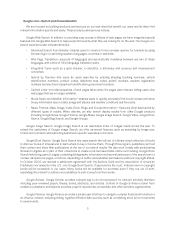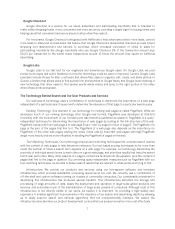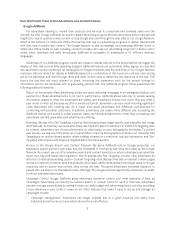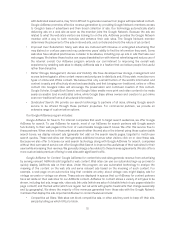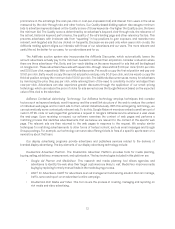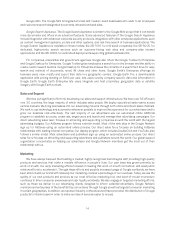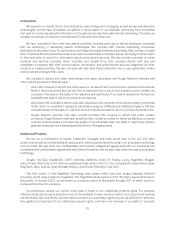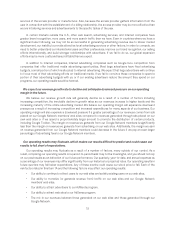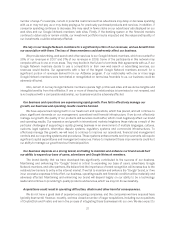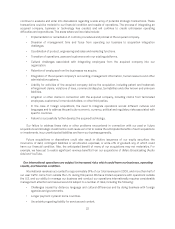Google 2008 Annual Report Download - page 28
Download and view the complete annual report
Please find page 28 of the 2008 Google annual report below. You can navigate through the pages in the report by either clicking on the pages listed below, or by using the keyword search tool below to find specific information within the annual report.prominence in the ad listings (the cost-per-click or cost-per-impression bid) and interest from users in the ad as
measured by the click-through rate and other factors. Our Quality-based bidding system also assigns minimum
bids to advertiser keywords based on the Quality scores of those keywords—the higher the Quality score, the lower
the minimum bid. The Quality score is determined by an advertiser’s keyword click-through rate, the relevance of
the ad text, historical keyword performance, the quality of the ad’s landing page and other relevancy factors. This
prevents advertisers with irrelevant ads from “squatting” in top positions to gain exposure, and rewards more
relevant, well-targeted ads that are clicked on frequently. Because we are paid only when users click on ads, the
AdWords ranking system aligns our interests with those of our advertisers and our users. The more relevant and
useful the ad, the better for our users, for our advertisers and for us.
The AdWords auction system also incorporates the AdWords Discounter, which automatically lowers the
amount advertisers actually pay to the minimum needed to maintain their ad position. Consider a situation where
there are three advertisers—Pat, Betty and Joe—each bidding on the same keyword for ads that will be displayed
on Google.com. These advertisers have ads with equal click-through rates and bid $1.00 per click, $0.60 per click
and $0.50 per click, respectively. With our AdWords discounter, Pat would occupy the first ad position and pay only
$0.61 per click, Betty would occupy the second ad position and pay only $0.51 per click, and Joe would occupy the
third ad position and pay the minimum bid of $0.01 per click. The AdWords discounter saves money for advertisers
by minimizing the price they pay per click, while relieving them of the need to constantly monitor and adjust their
cost-per-click. Advertisers can also experience greater discounts through the application of our smart pricing
technology, which can reduce the price of clicks for ads served across the Google Network based on the expected
value of the click to the advertiser.
AdSense Contextual Advertising Technology. Our AdSense technology employs techniques that consider
factors such as keyword analysis, word frequency and the overall link structure of the web to analyze the content
of individual web pages and to match ads to them almost instantaneously. With this ad targeting technology, we
can automatically serve contextually relevant ads. To do this, Google Network members embed a small amount of
custom HTML code on web pages that generates a request to Google’s AdSense service whenever a user views
the web page. Upon receiving a request, our software examines the content of web pages and performs a
matching process that identifies advertisements that we believe are relevant to the content of the specific web
page. The relevant ads are then returned to the web pages in response to the request. We employ similar
techniques for matching advertisements to other forms of textual content, such as email messages and Google
Groups postings. For example, our technology can serve ads offering tickets to fans of a specific sports team on a
news story about that team.
Our display advertising programs provide advertisers and publishers services related to the delivery of
branded display advertising. The key elements of our display advertising technology include:
DoubleClick Advertiser Platform. The DoubleClick Advertiser Platform provides tools for media planning,
buying, selling, ad delivery, measurement, and optimization. The key technologies included in this platform are:
•Google Ad Planner and MediaVisor. This research and media planning tool allows agencies and
advertisers to identify the web sites their target customers are likely to visit. MediaVisor improves media
buying by replacing formerly manual tasks in the media buying process.
•DART for Advertisers. DART for advertisers is an ad management and serving solution that can manage,
traffic, serve and report on an advertiser’s online campaign.
•DoubleClick Rich Media and Video. This tool covers the process of creating, managing and reporting on
rich media and video advertising.
12



